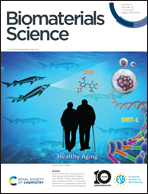The effect of chondroitin sulfate concentration and matrix stiffness on chondrogenic differentiation of mesenchymal stem cells†
Abstract
Chondroitin sulfate (CS), a glycosaminoglycan of native cartilage, has shown its potential in promoting chondrogenesis of mesenchymal stem cells (MSCs), whereas the effect of matrix stiffness in a CS-containing 3D environment on chondrogenesis is still poorly understood. Herein, this study aimed at assessing the effect of CS concentration and stiffness of CS-containing hydrogels on the chondrogenesis of MSCs. Hydrogels composed of 6% (w/v) gelatin methacryloyl (GelMA) and three concentrations, i.e., 4%, 6%, or 10% (w/v), of methacrylated chondroitin sulfate (CSMA) were prepared. The hydrogels of each composition were prepared with two stiffness values (33.36 ± 8.25 kPa vs. 8.42 ± 2.83 kPa). Physical characterization showed similar microporous structures among the six groups, higher swelling ratios and faster degradation in the soft hydrogel groups. MSCs were encapsulated in the six groups of hydrogels and they underwent 28-day chondrogenic differentiation. The cell viability in each group on day 1 was similar and most cells exhibited a round shape without spreading. Afterwards, cellular protrusions in soft hydrogels remained filopodium-like from day 14 to day 28, while most protrusions were lamellipodium-like in stiff hydrogels on day 14 and then transformed into a spherical shape on day 28. The expression of chondrogenic markers analysed by real-time qPCR and immunohistochemical staining demonstrated that the optimal CS concentration for chondrogenesis was 6% (w/v) regardless of the stiffness of hydrogels. In addition, with the same CSMA concentration, the trend was observed that the stiff hydrogels supported superior chondrogenesis of MSCs compared to the soft hydrogel. To summarize, this study presents an advancement in the optimization of CSMA concentration and stiffness of hydrogels for chondrogenesis. In the CSMA/GelMA hydrogel, 6% (w/v) CSMA with an initial Young's modulus around 33 kPa was recommended for cartilage tissue engineering.



 Please wait while we load your content...
Please wait while we load your content...